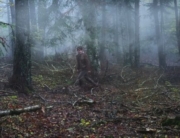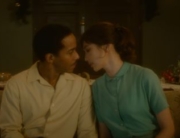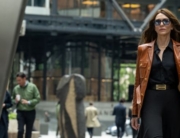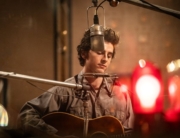![]() There is a lot to unpack and ruminate over in Jane Schoenbrun’s moody and extraordinarily layered film, where abstract ideas are made tangible. In a late-1990s nondescript suburbia, two loner teens, Owen and Maddy (played by Justice Smith and Brigette Lundy-Paine in remarkable turns), bond through feelings of otherness and their obsession with a late-night young adult TV show, The Pink Opaque, and its cast of queer-coded characters.
There is a lot to unpack and ruminate over in Jane Schoenbrun’s moody and extraordinarily layered film, where abstract ideas are made tangible. In a late-1990s nondescript suburbia, two loner teens, Owen and Maddy (played by Justice Smith and Brigette Lundy-Paine in remarkable turns), bond through feelings of otherness and their obsession with a late-night young adult TV show, The Pink Opaque, and its cast of queer-coded characters.
We only get scant glimpses of the teens’ homelives: Owen’s loving mother (Danielle Deadwyler) is dying of cancer, and his surly, disapproving father (an unsettling Fred Durst) fills Owen with dread. In one of the many scenes that effectively evokes contrast through sound design, Maddy relays to Owen her desire to escape the suburbs in the safe space of her basement as someone, likely Maddy’s father, shouts angrily on an upper floor. When she mysteriously disappears and The Pink Opaque is cancelled, the film plunges into the 2000s. It becomes almost suffocating to feel Owen’s continuous sadness and discomfort as he works in a drab movie theater with taunting male co-workers, or sits alone by a fire in a desolate wooded area.
A rueful meditation, the film forges ahead with surprising turns and surreal touches. I Saw the TV Glow is often so dreamlike that the decision to make the storyline somewhat linear is a smart one: It keeps things grounded, creating a powerful, overriding sense of time moving on while Owen is so caught in a rut.
Visually, a subtle vaporwave atmosphere creeps in here and there—from the bright glow of a Fruitopia vending machine to text upon the screen (an economical way to describe the episodes and lore of the TV show) to hot pink chalk words on a sidewalk that reveals a stirring message. Whether as a young child or a teen, Owen clings to a bright pink sleeping bag—something boys would be picked on for having in the late-’90s. These pops of color feel like lifelines in the bland abyss of its suburban setting. All of the scenes of The Pink Opaque—reminiscent of Buffy the Vampire Slayer, or a more trancelike version of the film The Craft—are gleefully strange and amusing. The use of a flat, ’90s video look strongly contrasts to the lusher hues and textures of the overall visual palate.
Additionally, the soundtrack wholly embraces the film’s earnest emo nature. The songs, mostly written directly for the movie, include a soaring centerpiece, “Starburned and Unkissed,” by Caroline Polachek. A Snail Mail cover of Smashing Pumpkins’ “Tonight, Tonight” conjures the band’s famed Georges Méliès–inspired music video, in turn an inspiration for the moon monster, Mr. Melancholy, in The Pink Opaque.
For some, media is purely entertainment, but for queer people it can be a way of exploring and embodying another existence. The trans documentary, Paul B. Preciado’s Orlando, My Political Biography, used Virginia Woolf’s novel as a springboard for its subject’s revelations. Having a TV show as exploring one’s sexuality, or even having a TV within oneself (a nod to David Cronenberg, no doubt), is inventively and emotionally captured here. Owen’s journey of self-actualization becomes scary, heartbreaking, yet hopeful toward the end. It’s amazing too that Schoenbrun’s film runs the gamut of these emotions so keenly.
A sold-out BAMcinématek screening of I Saw the TV Glow was followed by the director’s selection of a 35mm print of Tobe Hooper’s Poltergeist. Both movies skewer the conformity and doldrums of the suburbs, play imaginatively with sound design, and have characters who literally disappear into the ether of television. A lovely pairing and a witty, rollicking, robust night of cinema.

















Leave A Comment